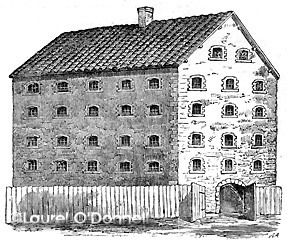|
|
Chapter III
Important Incidents of the Revolution
and Later History of Manhattan. New York Government at Sea—Plot to Assassinate Washington—Shocking Barbarity of English Officers—Hale and André, the Two Spies—Arnold in New York—British Evacuation—The Burr and Hamilty Tragedy of 1804—Robert Fulton and the “Clermont“—Public Improvements of 1825.
Shocking Barbarity of English Officers, continued
We present a cut of this memorable structure, which stood as a monument of the several periods through which it had passed until 1840, when it was demolished by the march of modern architectural improvements. This cut and several others in this volume were engraved by Alexander Anderson, M.D., when in his eighty-eighth year, and were obtained, with valuable information in relation to the prisons of the Revolution, from Charles I. Bushnell, Esq., of New York, who has perhaps taken a deeper interest in the study of that interesting period than any other writer of our times.
 Old Sugar-House in Liberty Street. But dreadful as were the prisons, and the old sugar-house in Liberty street, the prison-ships are of still more terrific memory. In 1779 the "Prince of Wales" and the "Good Hope" were used as prison-ships. The "Good Hope" being destroyed by fire the following year, several old hulks formerly employed as men-of-war were anchored in the North and the East rivers, and were called hospital ships, though it soon became apparent that they were but wretched prisons for captured Americans. Among these may be mentioned the "Stromboli," the "Scorpion," the "Hunter," the "Falmouth," the "Chatham," the "Kitty," the "Frederick," the "Glasgow," the "Woodland," the "Clyde," the "Perseverance," and the "Packet." But none attained such appalling notoriety, as a monstrous crucible of human woe, as the "Jersey." This vessel was originally a British line-of-battle ship, built in 1736, and carried sixty guns. She had done good service in the war with France, and had several times served as a part of the Mediterranean squadron. In the spring of 1776 she sailed for America as one of the fleet of Commodore Hotham, and arrived at Sandy Hook in the month of August. She was subsequently used as a storeship, then employed as a hospital ship, and was finally, in the winter of 1779-80, fitted up for a prison ship, and anchored near the Wallabout in the East river, near what is now the Navy Yard, where she lay until the close of the war, when the day of retribution arrived, and she was broken up and sunk beneath the muddy waters, of the East river to rise no more. Dismantled of her sails and stripped of her rigging, with port holes closed, with no spar but the bowsprit, and a derrick to take in supplies, her small lone flag at the stern became the appropriate but unconscious signal of the dreadful suffering that raged within. Hundreds of captured prisoners were packed into this small vessel, where, with but one meal of coarse and filthy food per diem, without hammocks, or physicians, or medicines, or means of cleanliness, they wretchedly perished. Thousands of emaciated skeletons were during these perilous years cast into the billows of the bay, or left half covered in the sand banks and trenches. The bones of the dead lay exposed along the beach; drying and bleaching in the sun, whitening the shore until washed away by the surging tides. About twelve thousand prisoners are believed to have died on these vessels, most of whom were young men, the strength, and flower of their country. |
|
35
:: Previous Page :: Next Page ::
Books & articles appearing here are modified adaptations
from a private collection of vintage books & magazines. Reproduction of these pages is prohibited without written permission. © Laurel O’Donnell, 1996-2006.
|
|